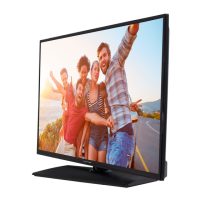Why does Sceptre X40 display turn off automatically after 10 minutes?
- GGabriel HobbsSep 4, 2025
The Sceptre display features a power saving mode which will automatically turn off the display if there’s no signal provided for more than 10 minutes.

Why does Sceptre X40 display turn off automatically after 10 minutes?
The Sceptre display features a power saving mode which will automatically turn off the display if there’s no signal provided for more than 10 minutes.
Why is there noise or trash pixels on the screen of my Sceptre X40 Monitor?
When your Sceptre monitor's resolution is higher than the digital channel’s broadcast resolution, the signal is up-converted to match your display’s resolution. This up-converting process can result in noise or trash pixels on the screen.
How to fix no sound on PC with Sceptre X40?
If there is no sound on your Sceptre monitor when connected to a PC, ensure that you have a 3.5 mm mini-jack cable connected from your PC's sound output to the display's VGA STEREO INPUT.
What to do if HDCP video has no audio on Sceptre Monitor?
If your HDCP video on your Sceptre monitor has no audio, ensure a 3.5 mm mini-jack cable is connected from your HDCP video device's sound output to the display's VGA STEREO INPUT. If your HDCP video device uses RCA AUDIO jacks, you'll need an RCA audio to 3.5 mm mini-jack cable.
Why does Sceptre Monitor picture not cover the entire screen?
If the picture on your Sceptre monitor does not cover the entire screen, and you're using HDMI or a digital channel, use the ASPECT button to switch to the 16:9 format. If you're using VGA, use the AUTO ADJUST function. For analog channels, AV, or component in 480i resolution, use the ASPECT button to switch to 16:9.
Why is the picture distorted or has abnormal sound on my Sceptre Monitor?
Distorted picture or abnormal sound on your Sceptre monitor might be due to interference from large electrical appliances, cars, motorcycles, or fluorescent lights. If the monitor is close to a wall, try moving it to another room to see if the problem persists.
Why is there no color on my Sceptre Monitor?
If your Sceptre Monitor is displaying no color, adjust your picture settings to ensure that the saturation and RGB settings are not turned all the way down. Also, ensure that the tuner signal is not lower than 65%.
How to fix weak signal or no program symbol on Sceptre Monitor?
If you're experiencing a weak signal or see a 'no program' symbol on your Sceptre monitor, try changing the direction of your antenna and then rescan for channels. If you have cable service, contact your cable company to inquire about the signal strength of your local cable.
Why does my Sceptre X40 Monitor have abnormal colors?
To correct abnormal colors on your Sceptre monitor, ensure that the colors on the cables match the corresponding ports on the back of the monitor. For example, connect the red cable to the red colored port.
What to do if Sceptre Monitor audio only no picture?
If your Sceptre Monitor is showing audio but no picture, ensure that both your video and audio cables are connected properly. If you are using a tuner, check that the tuner signal is at least 65%.
Provides phone number and email for technical support.
Advises against hazards, details electrical safety, and proper plug use.
Warns against unstable surfaces, advises caution when moving, and proper plug insertion.
Instructions for safe operation, including avoiding water and heat sources.
Guidance on polarized plugs, grounding, and power cord protection.
Switching power off before connecting components and unplugging for cleaning.
Ensuring proper airflow through slots and avoiding blocking openings.
Information on grounded plugs and power cable replacement.
Covers grounding, moisture, spills, and avoiding overloading electrical components.
Discourages self-repair, warns against humidity/dust, and handling abnormal conditions.
Guidelines for grounding antenna systems for protection against surges.
Details HEADPHONE, SPDIF, Analog Audio Out, Video, and YPbPr connection types.
Explains HDMI ports, MHL functionality for phones, and ROKU stick compatibility.
Visual guide to the buttons and their general functions on the remote control.
Detailed explanation of buttons like POWER, INFO, FREEZE, SLEEP, PICTURE, SOUND, etc.
Covers navigation, source selection, and ROKU™™ specific buttons.
Illustrates the source select menu options available on the display.
Explains how remote buttons (directional, ENTER, MENU, EXIT) control OSD navigation.
Details how side panel buttons (SOURCE, MENU, CH, VOL) function for OSD control.
Describes the PICTURE menu for adjusting sharpness, color, tint, and contrast.
Explains the SOUND menu for adjusting surround mode, bass, treble, and AVL.
Covers Picture Mode, Brightness, Contrast, Color, Tint, and Sharpness settings.
Details Screen Size options and PC-specific adjustments like Auto Adjust.
Explains Dynamic Contrast and Film Mode for optimizing picture quality.
Details Noise Reduction and MPEG Noise Reduction for reducing pixilation.
Covers Sound Mode presets and adjusting Bass, Treble, and Balance.
Explains BALANCE for stereo adjustment and SURROUND MODE for wider sound.
Explains how to view and manage favorite channels.
Instructions for setting a password to access parental control features.
Details US and Canada V-CHIP ratings for blocking content by age and rating.
Explains how to change the password and lock the keypad.
Solutions for no picture, abnormal colors, dark picture, and audio-only issues.
Troubleshooting for remote not working and insufficient channels.
Resolving universal remote code problems and PC connection issues.
Solutions for time setting, black boxes, and volume changes with channels.
Provides email, phone number, and operating hours for technical assistance.
Technical details on screen size, resolution, brightness, contrast, and dimensions.
Details on sleep timer, PC timing, multimedia formats, and tuner standards.
Explains the one-year limited warranty on parts and labor for new products.
Lists conditions and damages not covered by the warranty.
